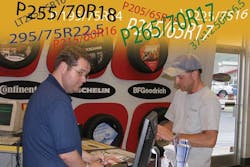Change is dangerous if left unmanaged
The changes we are going to discuss in this month’s article and the next revolve around overcoming two major problems that have several contributing factors. The problems are having the necessary tires on hand and how to handle an out-of-stock situation.
The contributing factors to out-of-stock conditions and lost sales revolve around three things —the explosion of SKUs, the cost associated with inventorying tires, and consumers who have done more research before contacting the retailer.
All three of these changing dynamics translate into “change points,” which when properly managed equal opportunity to win business and increase profitability. Unmanaged, they will lead to the deterioration of business revenue.
In previous articles we have discussed how SKU proliferation affects the tire dealer, the counter staff and the consumer. With the rapid addition of new vehicle categories such as crossovers and hybrids, and the rebirth of the American muscle cars, etc., tire sizing and fitments continue to grow in both number and complexity.
In 1980, 102 tire SKUs were required for 80% vehicle coverage. This number has steadily increased to the current 352 SKUs — and it continues to grow! The challenge of having the right tire(s) in stock to meet consumer need has become increasingly difficult. Having the right tire at the right price with the right acceptability for each individual customer is challenging enough, but that’s not all. The “right” tires cost more to inventory today; much more.
There was a time when certain-sized tires were “cross-vehicle, cross-platform and cross-manufacturer.” One tire fit many vehicles. Today it’s significantly more complex and expensive. Example: In mid-December, Cadillac premiered its new CTS Sport Wagon. The premium model has “staggered” 19-inch tires — size 255/40R19 on the front, 265/35R19 on the rear. Cadillac will sell a limited number of these vehicles, introducing still more low replacement rate SKUs into the marketplace.
In the years to come customers may call local tire retailers and inquire about tires for their CTS Sport Wagon, and the reply will be, “We don’t have them in stock.” The local retailer is at a distinct disadvantage. It makes no financial sense to inventory the replacement tire for the CTS Sport Wagon because the retailer only services the local market with limited demand. However, the “big online guys” can afford to inventory slow replacement SKUs because they service the entire nation. Selling over one million tires a month, they can afford to stock slower turnover SKUs.
This trend is not going to change any time soon. Therefore, you must rethink your approach and develop workable solutions for handling out-of-stock conditions for your business, for your employees, and for your customers!
Next month, we will take a look at what I call the “Zat Method.” Here’s an example of the Zat Method in practice: “I don’t currently have your tire size in stock. May I have your name and the best way to reach you? I’ll do some research and get back to you with a price and availability as soon as possible — no later than noon today. How’s Zat sound?”
Until next month, remember: Better, more professional handling of out-of-stock conditions leads to better profitability. How’s Zat sound?
Wayne Williams is president of ExSell Marketing Inc., a “counter intelligence” firm based in La Habra, Calif. He can be reached at [email protected].
